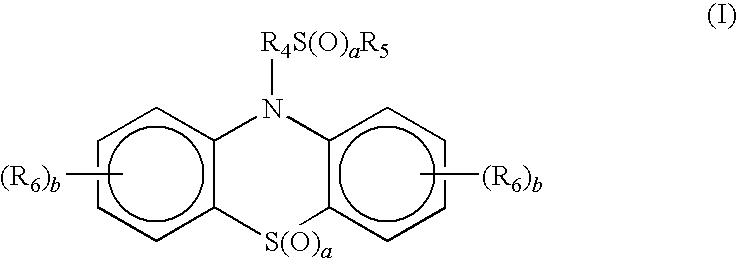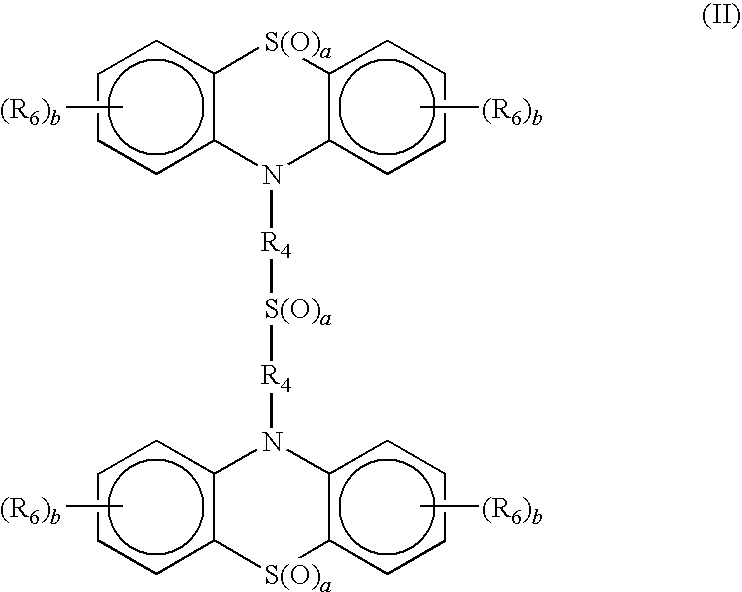Lubricating compositions with improved oxidation resistance containing a dispersant and an antioxidant
a technology of dispersant and antioxidant, applied in the direction of lubricant composition, liquid carbonaceous fuel, additives, etc., can solve the problems of increasing the oxidation of the lubricating composition, prone to viscosity increase of the lubricant, and rendering the lubricant unsuitable for use, so as to reduce the viscosity increase and improve the oxidation resistance. , the effect of favorable carbon/varnish ratings
- Summary
- Abstract
- Description
- Claims
- Application Information
AI Technical Summary
Benefits of technology
Problems solved by technology
Method used
Image
Examples
example b-1
[0099](a) An acylated nitrogen composition is prepared by reacting 3880 grams of the polyisobutenyl succinic anhydride, 376 grams of a mixture of triethylenetetramine and diethylene triamine (75:25 weight ratio), and 2785 grams of mineral oil in toluene at 150° C. The product is vacuum stripped to remove toluene.
[0100](b) A mixture of 62 grams (1 atomic proportion of boron) of boric acid and 1645 grams (2.35 atomic proportions of nitrogen) of the acylated nitrogen composition obtained from B-1(a) is heated at 150° C. in nitrogen atmosphere for 6 hours. The mixture is then filtered and the filtrate is found to have a nitrogen content of 1.94% and a boron content of 0.33%.
example b-2
[0101]A mixture of 372 grams (6 atomic proportions of boron) of boric acid and 3111 grams (6 atomic proportions of nitrogen) of a acylated nitrogen composition, obtained by reacting 1 equivalent of a polybutenyl ( Mn=850) succinic anhydride, having an acid number of 113 (corresponding to an equivalent weight of 500), with 2 equivalents of a commercial ethylene amine mixture having an average composition corresponding to that of tetraethylene-pentamine, is heated at 150° C. for 3 hours and then filtered. The filtrate is found to have a boron content of 1.64% and a nitrogen content of 2.56%.
example b-3
[0102]Boric acid (124 grams, 2 atomic proportions of boron) is added to the acylated nitrogen composition (556 grams, 1 atomic proportion of nitrogen) of Example B-2. The resulting mixture is heated at 150° C. for 3.5 hours and filtered at that temperature. The filtrate is found to have a boron compound of 3.23% and a nitrogen content of 2.3%.
PUM
| Property | Measurement | Unit |
|---|---|---|
| kinematic viscosity | aaaaa | aaaaa |
| kinematic viscosity | aaaaa | aaaaa |
| temperature | aaaaa | aaaaa |
Abstract
Description
Claims
Application Information
 Login to View More
Login to View More - R&D
- Intellectual Property
- Life Sciences
- Materials
- Tech Scout
- Unparalleled Data Quality
- Higher Quality Content
- 60% Fewer Hallucinations
Browse by: Latest US Patents, China's latest patents, Technical Efficacy Thesaurus, Application Domain, Technology Topic, Popular Technical Reports.
© 2025 PatSnap. All rights reserved.Legal|Privacy policy|Modern Slavery Act Transparency Statement|Sitemap|About US| Contact US: help@patsnap.com



